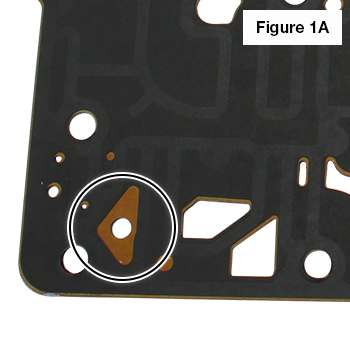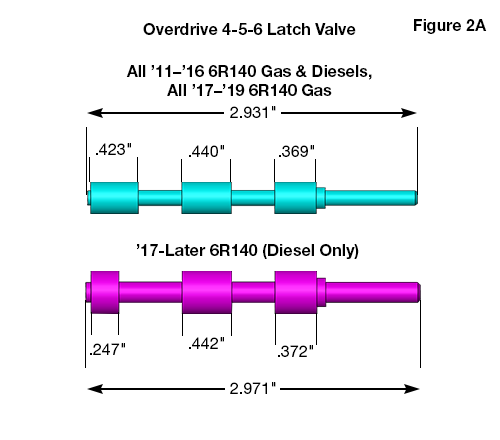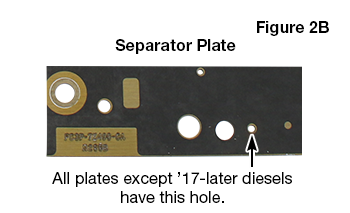June 13, 2019
Ford 6R140 Separator Plate Identification – How to Identify Changes & Interchangeability
Eric Streed
Ford Motor Company introduced the 6R140 transmission, paired with the 6.7L diesel, in early 2010 for the 2011 model year production. This has created confusion when trying to identify valve body components, as new model year release is usually near the end of the previous year. Valve body and separator plates have gone through numerous updates since the beginning of 6R140 production. This article will illustrate changes, function and interchangeability.
Valve Body Casting & Separator Plate Identification
First generation of castings (’11–’14 model year) have a 10 through 13 casting year on valve body. The rough forging number for the first production valve body castings end with “EB.”
The first production separator plates have no notches for external identification, but do have the engineering part number stamped on them of BC3P-7Z490-EB, -EC, -ED or -EE, which is visible externally.
The first production valve body assemblies had one change made to them in ’13–’14. A damper location was cast in the lower valve body, but not originally finished to accept a damper piston. This changed in ’13–’14 when the valve body casting was machined to accept a third dampener piston assembly that is used in the “D” Low/Reverse solenoid output circuit. The separator plate was also changed to provide a feed hole to this piston and is identified with engineering stamping BC3P-7Z490-EE.
In 2015 model year production (14-later casting number), the valve body went through major worm track configuration changes. The rough forging casting numbers end in “BA” and are used all the way up through 2019. Based on the hundreds of core samples, there are four separator plates that have been identified to fit “BA” castings, that are distinguished by a “C,” “CC,” “V” or “VV” notch in the plate. The following are changes in plate and valve body combinations:
Cold Lube Passage
This passage feeds converter-out oil to lube until the thermostat opens at approximately 195°F. The converter limit valve works in conjunction with this feed to control how much converter-out oil is fed to lube. Most units have a large triangle-shaped feed, but some later plates have a smaller, round feed (Figure 1). In ’17-later diesel applications, this passage isn’t functional since Ford moved the thermostat outside the valve body, mounting it to the transmission cooler. The thermostat is replaced by a plug in the valve body in ’17-later diesel applications.
| Figure 1 – Cold Lube Passage Identification | |
|---|---|
 |  |
2-6 Cutback Feed
For all gas and ’11–’16 diesels, Ford uses a hole in the separator plate to feed oil to the 2-6 regulator valve once the transmission is in 4th Gear and above. Ford accomplishes this by feeding oil through the 4-5-6 latch valve to the 2-6 regulator valve. Hydraulic ratio of the 2-6 regulator valve during 1-2 upshift is 2.3:1. When oil is routed through the 4-5-6 latch valve to 2-6 regulator valve for the 5-6 upshift, the hydraulic ratio is 1.24:1. All gas and diesels from ’11–’16 have this hole in plate. For whatever reason, Ford removed this hole only from the “VV” plate in the ’17-later diesels. All plates have this passage except the “VV” plate. The hydraulic ratio with “VV” plate is 2.3:1 for both 1-2 and 5-6 upshift.
When Ford made this plate change, they also made a valve change. The 4-5-6 latch valve (Figure 2) now has one land that is narrower than previous versions. The plate and valve must be used together. The 4-5-6 latch valve bore didn’t change, so valves can be swapped. A harsh 5-6 upshift will result if a “VV” plate is used in the wrong application. This rough shift is a result of 2.3:1 hydraulic ratio on 5-6 upshift. In summary, use the “VV” plate only with the “narrow land” 4-5-6 latch valve and only in ’17-later diesel applications.
| Figure 2 – 2-6 Cutback Feed Identification | |
|---|---|
 |  |
Dampeners
This only applies to early (10–13) casting numbers, ’11–’14 model year, which use plates with no notches. A technician can put a three-dampener plate and casting in place of a two-dampener system.
Feed Passages to Shift Valves
On the “V” plate only, Ford feeds certain shift valves directly from pressure regulator valve versus going through manual valve.
Interchange
Only plates with no ID notches will fit on early castings, ’11–’14 model year (10–13 casting year). Early castings have casting numbers ending in “EB.” A technician just needs to pay attention to whether it’s a two-dampener or three-dampener setup.
Only notched plates can be used with ’15-later model year (’14-later casting year). These casting numbers end in “BA.” The builder still needs to pay attention to all the differences between “C,” “CC,” “V” and “VV” plates.
We believe Ford is using ’14-later casting numbers with correct plate combination to service earlier transmissions, but more ID work needs to be done. Refer to chart for plate variations.
| Start | Last | Plate ID Notch | Plate Ford Service PN | Plate Ford Engineering PN | Dampeners | Cold Lube Passage | 2-6 Cutback Feed | Feed to Shift Valves | Application |
|---|---|---|---|---|---|---|---|---|---|
| 2011 Model Year | Thru Sept. 2012 | No ID | BC3Z-7Z490-E | BC3P-7Z490-ED | 2 | Triangle | Yes | Manual Valve | Gas & Diesel |
| Oct. 2012 | 2014 Model Year | No ID | BC3Z-7Z490-F | BC3P-7Z490-EE | 3 | Triangle | Yes | Manual Valve | Gas & Diesel |
| 2015 Model Year | 2016 Model Year | C | FC3Z-7Z490-C | FC3P-7Z490-CA | 3 | Triangle | Yes | Manual Valve | Gas & Diesel |
| 2017 Model Year | — | CC | HC3Z-7Z490-C | HC3P-7Z490-CA | 3 | Hole | Yes | Manual Valve | Gas Only |
| 2016 Model Year | — | V | FC3Z-7Z490-B | FC35-7Z490-BA | 3 | Triangle | Yes | PR Valve | Gas Only |
| 2017 Model Year | — | VV | HC3Z-7Z490-D | HC3P-7Z490-DA | 3 | Hole | No | Manual Valve | 6.7L Diesel |
Various models use different plates. Be sure to consult the Ford dealer with VIN number to correct plate part number.
Eric Streed is a Sonnax design engineer. He is a member of the Sonnax TASC Force (Technical Automotive Specialties Committee), a group of recognized industry technical specialists, transmission rebuilders and Sonnax Transmission Company technicians.
Learn More
July 08, 2022
How to Identify Ford 6R140 Torque Converter Features & Avoid Application Pitfalls
Steve Jaussaud
August 15, 2022
Troubleshooting Ford 6R80 & 6R140 Timing-Related Shift Issues
Jim Dial
Related Units
Related Parts
While Sonnax makes every effort to ensure the accuracy of technical articles at time of publication, we assume no liability for inaccuracies or for information which may become outdated or obsolete over time.
